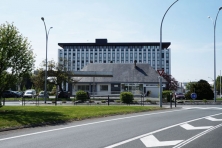Positive Loops
Angers (FR) - Winner
TEAM DATA
Team Representative: Solenne Sari (FR) – architect
Associates: Pierric Amella (FR), Florian Camani (FR), Mathilde Luguet (FR) – urbanist architects
13 rue Louis Bonnet, 75011 Paris (FR)
+33 6 38755088 – contact@positiveloops.eu – positiveloops.eu
See the complete listing of portraits here
See the site page here

P. Armella, M. Luguet, S. Sari & F. Camani
INTERVIEW
Click on the images to enlarge
1. How did you form the team for the competition?
We met as students at Bordeaux, Paris La Villette and Valencia architecture schools. For 10 years, we’ve worked individually on several offices in Barcelona, Paris and Lille, while exchanging on our projects, wants and ideas on the contemporary city. 2017 marked a turning point: Solenne set up her own urban design consultancy 2S-AU, Florian and Mathilde created FCML architects, focusing on architecture and research, and Pierric established his multidisciplinary studio Samuel Romain Amella. Europan provided the perfect opportunity for us to mold our complementary visions and ideas into a concrete, achievable project.
2. How do you define the main issue of your project, and how did you answer on this session main topic: the place of productive activities within the city?
One question kept coming back in our conversations: what’s a productive activity in the context of a global ecological crisis? To answer that, we were inspired by the circular economy, and we first identified the existing mobilizable resources. Our goal: one’s waste must become a source of wealth for the other. With its diversity of activities, St Serge’s area gathers professionals from the food, the building and the car industries, along with many stores. Each specialty could find compatibilities with another activity. Through four examples of “positive loops”, we tend to reveal those ignored resources and transform them into driving forces for Saint Serge sector’s renewal.
3. How did this issue and the questions raised by the site mutation meet?
The area is an industrial land inherited from the 20th century urbanism. Today, traditional production is living a revolution. How can we transform this sector for the 21st century while reconnecting it with its context, finding new bonds between landscape, geography, and economy? We see the site’s constraints (submersibility, contamination, disaffections, future mutations) as opportunities, which should deliver a sustainable urban renewal while improving the common good. It’s a deeply optimistic project, it puts together public and private actors in a “win-win” logic. We identified several “positive loops”, and we developed four of them: the economy of recycling and reuse, the exploitation of a productive vegetation within the sector, the higher land value by redesigning public spaces, the construction of capable structures able to evolve according to the area’s needs.
4. Have you treated this issue previously? What were the reference projects that inspired yours?
We’re regularly confronted to urban regeneration, but on most of the sites, housing is the main program. Production is rarely the driving force of the project. Nevertheless, we already worked on those themes for the 2012 French National Workshop on Economical Areas, guided by Cristina Garcez, and for a tender procedure on the industrial-port of Salaise Sablons (FR) in 2015. To develop “positive loops”, we were inspired by the idea of circular economy, by the conclusions of the Ateliers de Maîtrise d’oeuvre de Cergy, but also by the diversity of uses in Tokyo’s architecture, or by the Productive Bruxelles Workshop’s research.
5. Urban-architectural projects like the ones in Europan can only be implemented together with the actors through a negotiated process and in time. How did you consider this issue in your project?
This question is the basis of our project: we find stakeholders, resources, times, projects (private or public ones), and we create some synergy, to kickstart an urban and economic renewal, while improving the common good. With our “positive loops”, the goal no longer is “how can we build this design we did previously”, but “how can we use every initiative to galvanize sustainably this neighborhood”. Each “loop” is independent yet compatible. It’s a reproducible, extensible, negotiable method, improvable with the economic and political actors. Thematic workshops can help develop the process, they can generate schedules for complementary actions, and finally allow the sector’s sustainable renewal.
6. Is it the first time you have been awarded a prize at Europan? How could this help you in your professional career?
Each one of us already participated to Europan twice before this session, in France and elsewhere. Our projects have already been pre-selected, but it’s the first time we win. Beyond the competition, the research and method we developed will enhance our daily work in our respective offices. We really hope we’ll be able to continue and develop this project, and together transform those ideas into something more operational.





